Wat Pho and the Temple of Dawn
In the last post we visited the UNESCO World Heritage Site of Ayutthaya as well as the summer palace of the Thai monarchs nearby. In this final post from Thailand, at least for this visit, Alison and I will return to Bangkok. While the title of this short post sounds like something straight out of an Indiana Jones movie, it is actually a reference to two of Bangkok’s must see Buddhist temples, Wat Pho and the Temple of Dawn. Please join as us we seek to learn more about the tenets of this ancient religion.
Wat Pho
The first thing I learned about Buddhist temples or wats is that unlike Greek or Roman temples which are singular buildings, a wat is a complex involving many different buildings, monuments and other structures as well as gardens. So think of Wat Pho more in terms of the Acropolis of Athens which has not only the Parthenon, but a number of other temples as well. It is located very close to the Royal Palace which we visited in a previous post, but is actually much older, predating the founding of Bangkok by some hundred years or more when it was established as a monastery. However it was King Rama I, the man who established the Royal Palace who was responsible for making Wat Pho the important temple complex that it is today. He made it the keeper of many images of the Buddha that he had transferred from the wreckage of Ayutthaya after the Burmese were expelled. Today it houses the largest collection of Buddha images in Thailand and ranks as one of six top-level temple complexes in the country. BTW the proper name of Wat Pho is way longer than the shortened version and apparently refers to the monastery of the Bodhi tree in India where Buddha is said to have achieved enlightenment around 500 BCE.
In the mid 19th century King Rama III made a number of secular improvements to Wat Pho that enhanced its reputation including establishing the first public university in Thailand on the premises as well as making it the centre for the teaching of Thai massage techniques. He was also responsible for creating a huge reclining Buddha which is the primary tourist attraction at Wat Pho and gives it the commonly used name by tourists – The Temple of the Reclining Buddha.
So with that short history let’s join our guide Su from Trails of Indochina to begin exploring Wat Pho.
To get there we hop into one of Bangkok’s ubiquitous tuktuks, a ridiculously cheap and quick way of getting around the central part of the city and they’re a lot of fun besides.
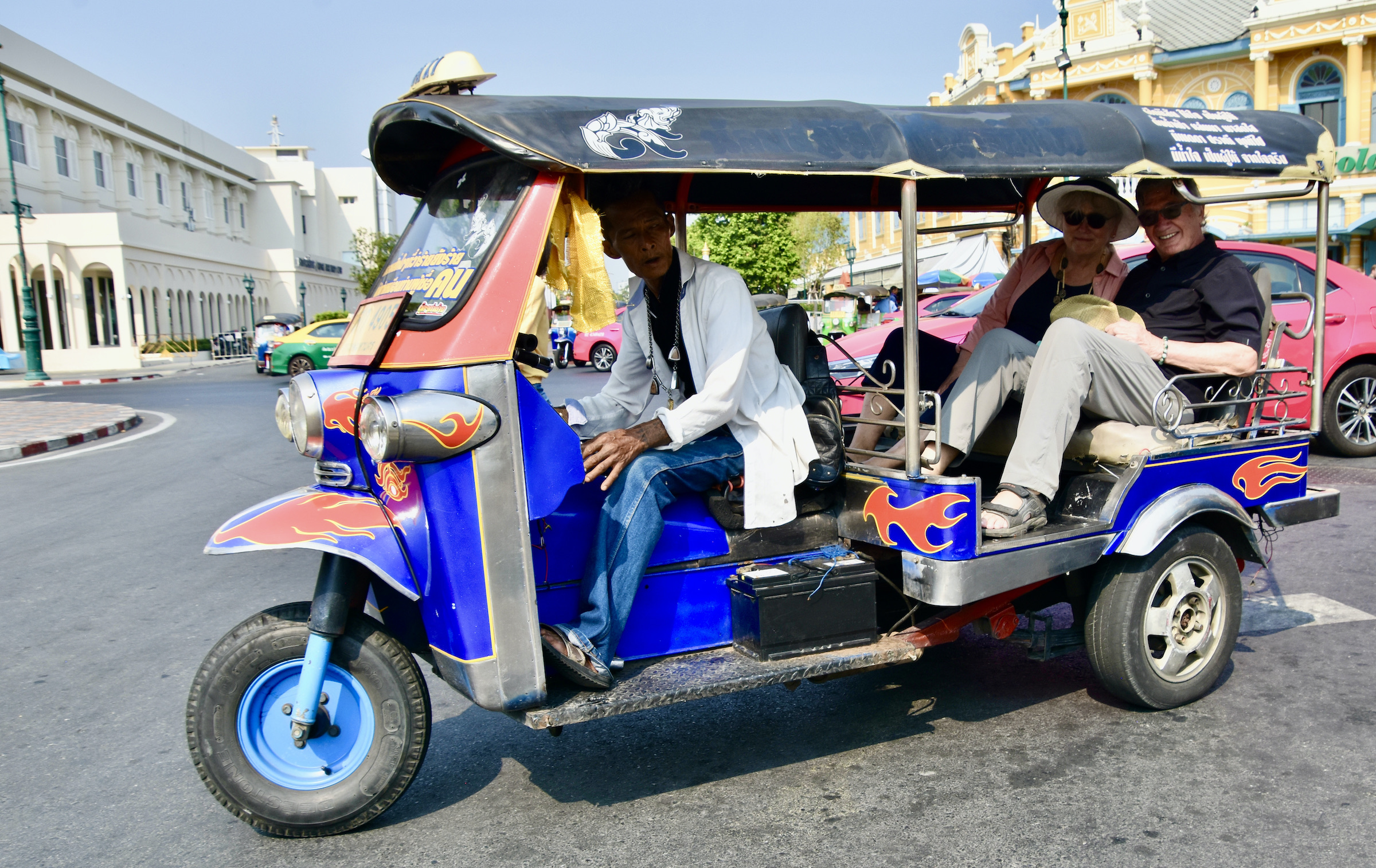
Wat Pho is a huge complex, not quite on the scale of the Royal Palace, but with twenty distinct buildings. Even though the Temple of the Reclining Buddha is listed as #1 on the map it is actually quite far from the entrance and will be the last place we visit at Wat Pho.
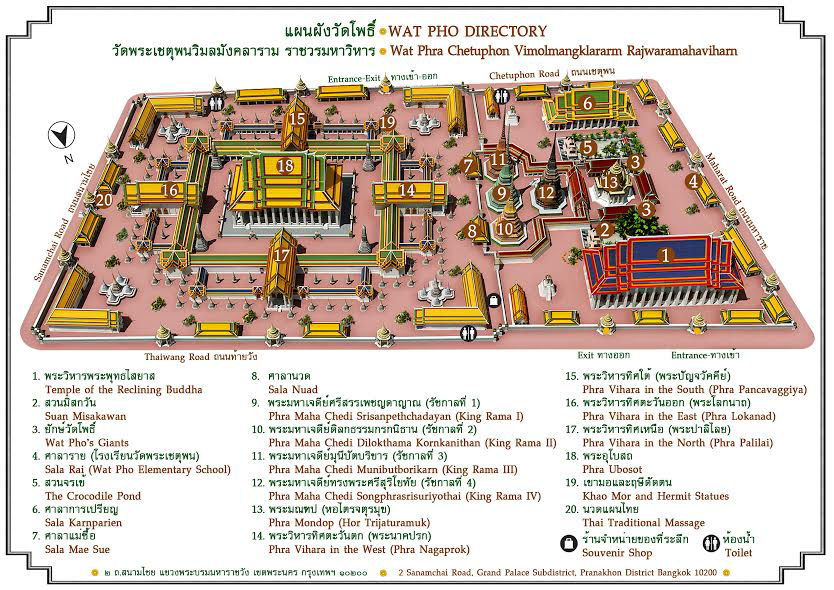
Upon entering Su leads us to the large complex that dominates the left hand side of the map. You’ll note the large square cloister that surrounds a central temple. There are four smaller temples connected to the cloister on each side. These make up the Phra Vihara Tis, each of which houses a statue of Buddha in a different pose, representing the various stages of his journey to enlightenment. In between each vihara are rows of buddhas such as below which Rama I had brought from Ayutthaya. All told there are over 1,000 Buddha images at Wat Pho, the largest collection in Thailand. These Buddhas are in the Earth Touching pose, representing Buddhas final moment of enlightenment.
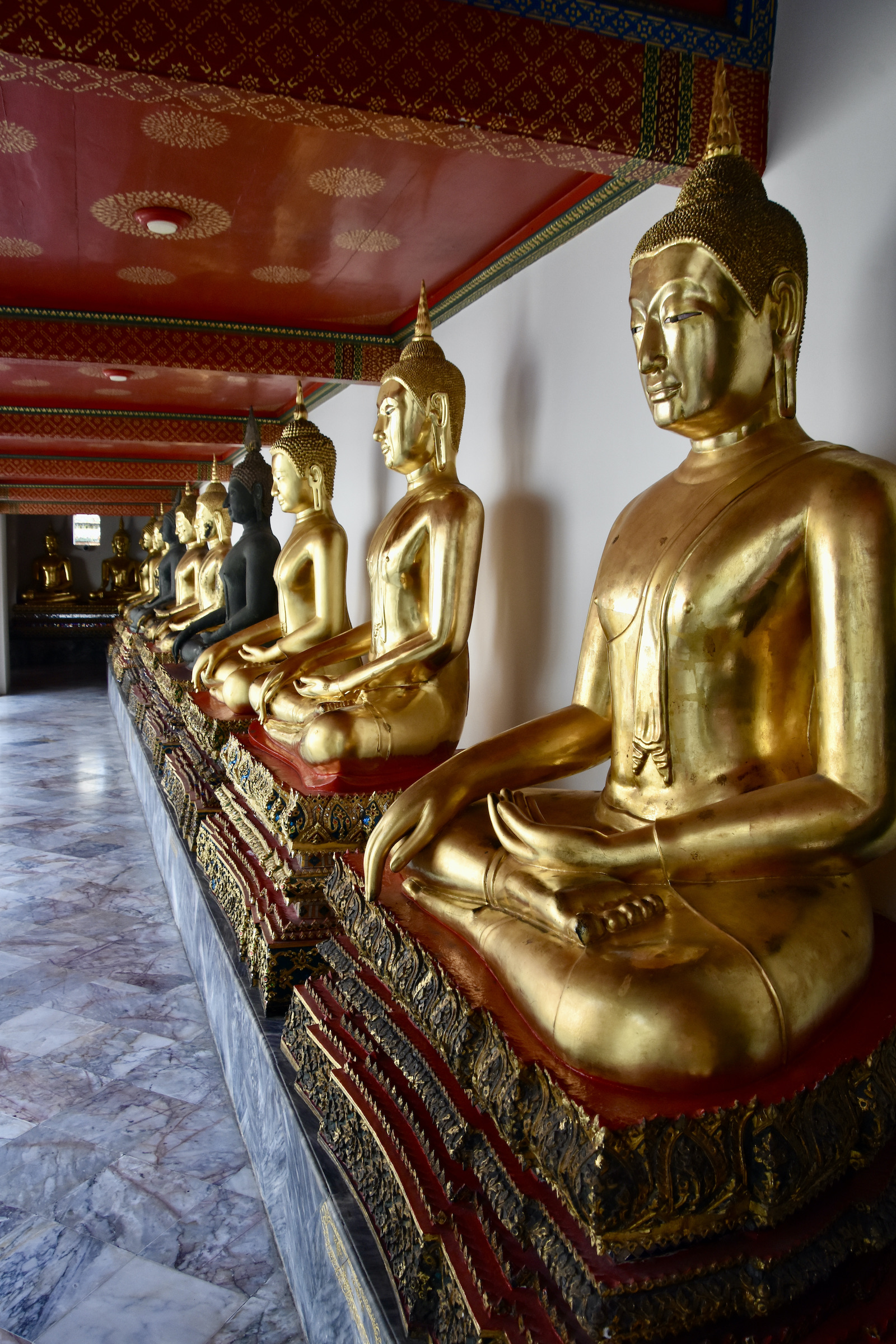
This is a straight on view of three of them. You can see that although they at first glance they appear quite similar and they are, but a closer look shows that each has distinct features and they are not just cloned copies. These are really entrancing woks of art.
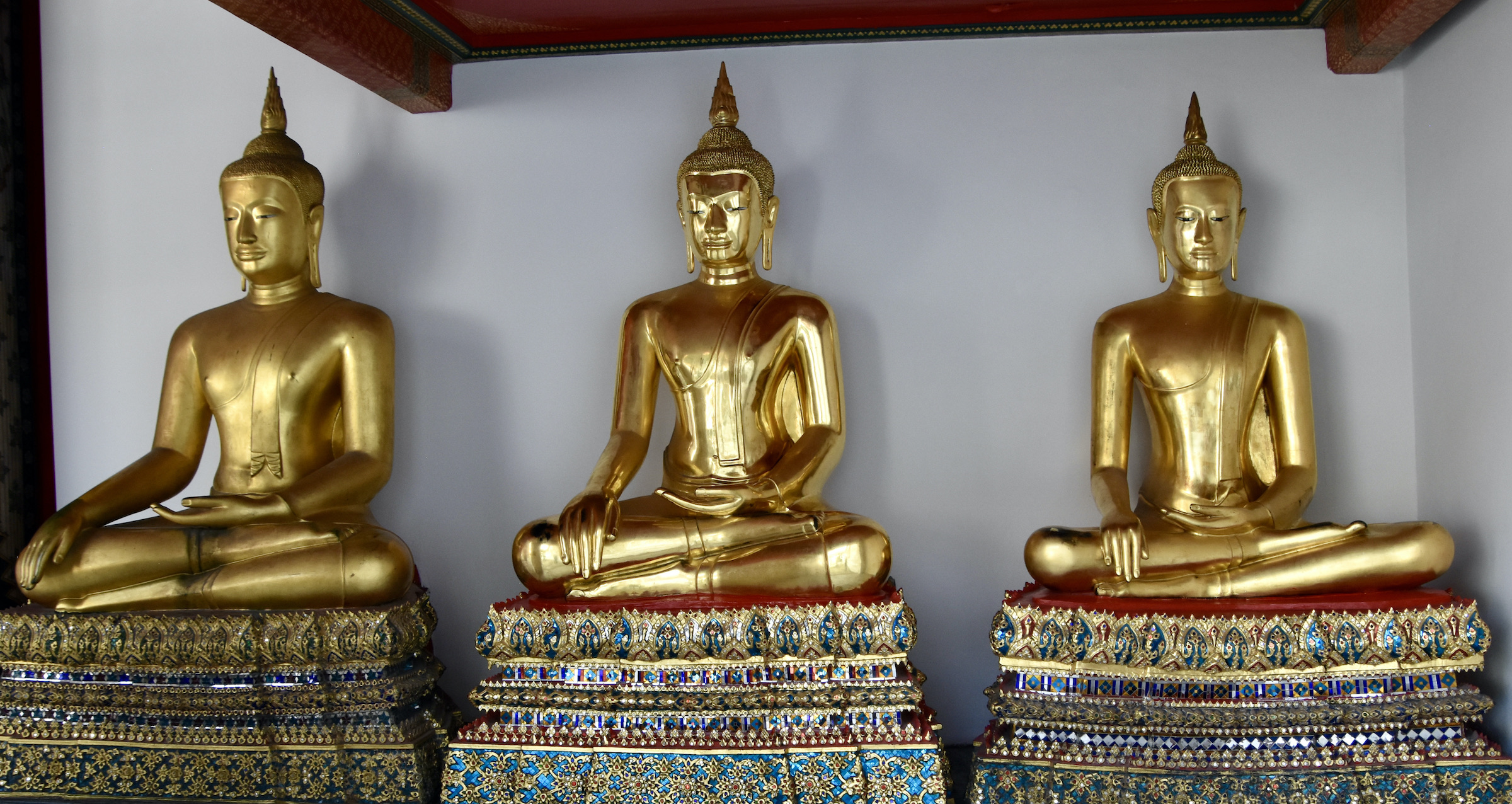
In the east vihara, Phra Lokanad, there is a 10 metre (33 foot) statue of Buddha in the standing position which was brought from Ayutthaya.
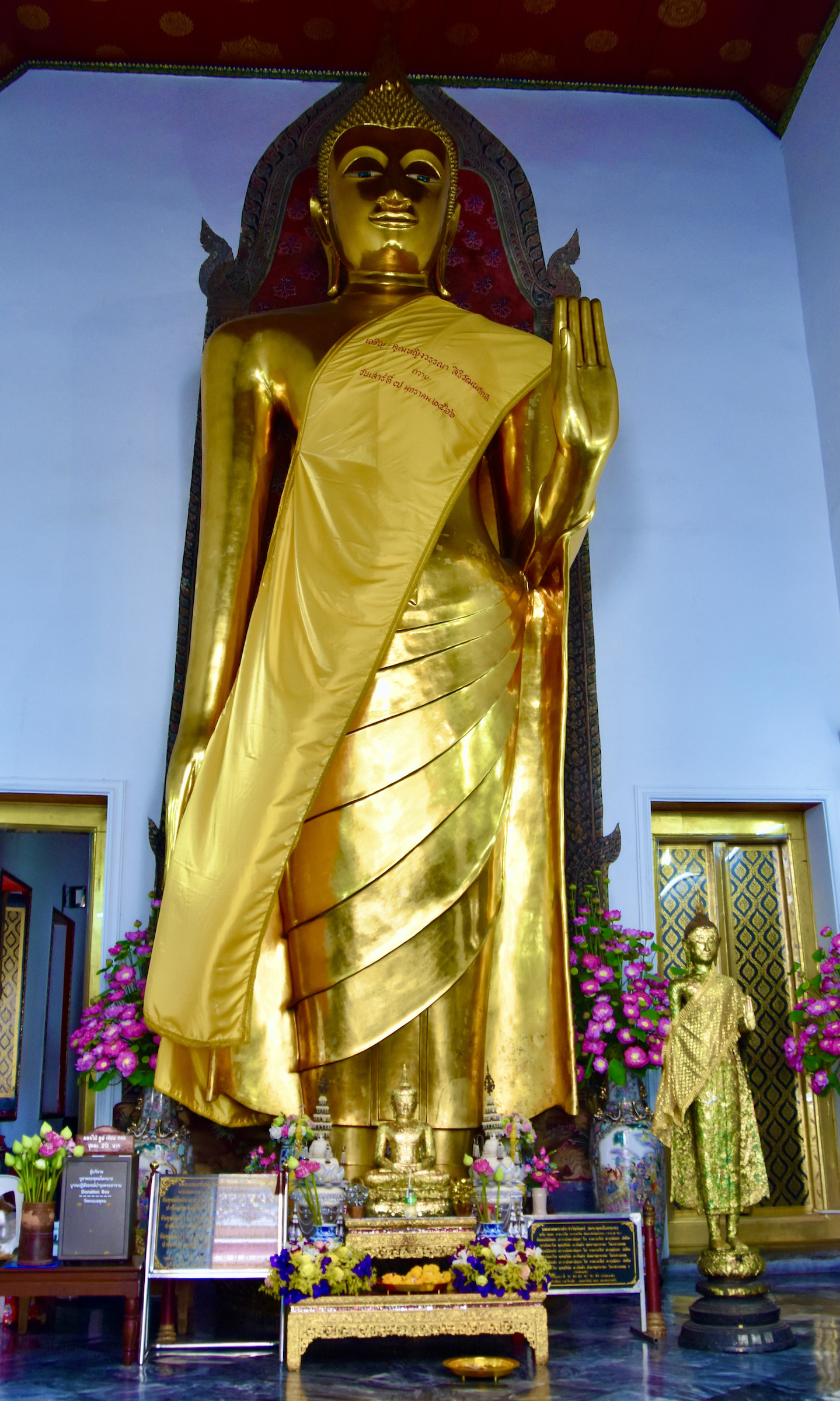
The large temple enclosed by the cloister is Phra Ubosot, the Buddhist assembly hall and largest place of worship at Wat Pho. We are here on a religious holiday and devote Buddhists have indeed assembled in great numbers and are listening to a recitation by a senior monk. We take a quick look inside, but out of respect do not go any further.
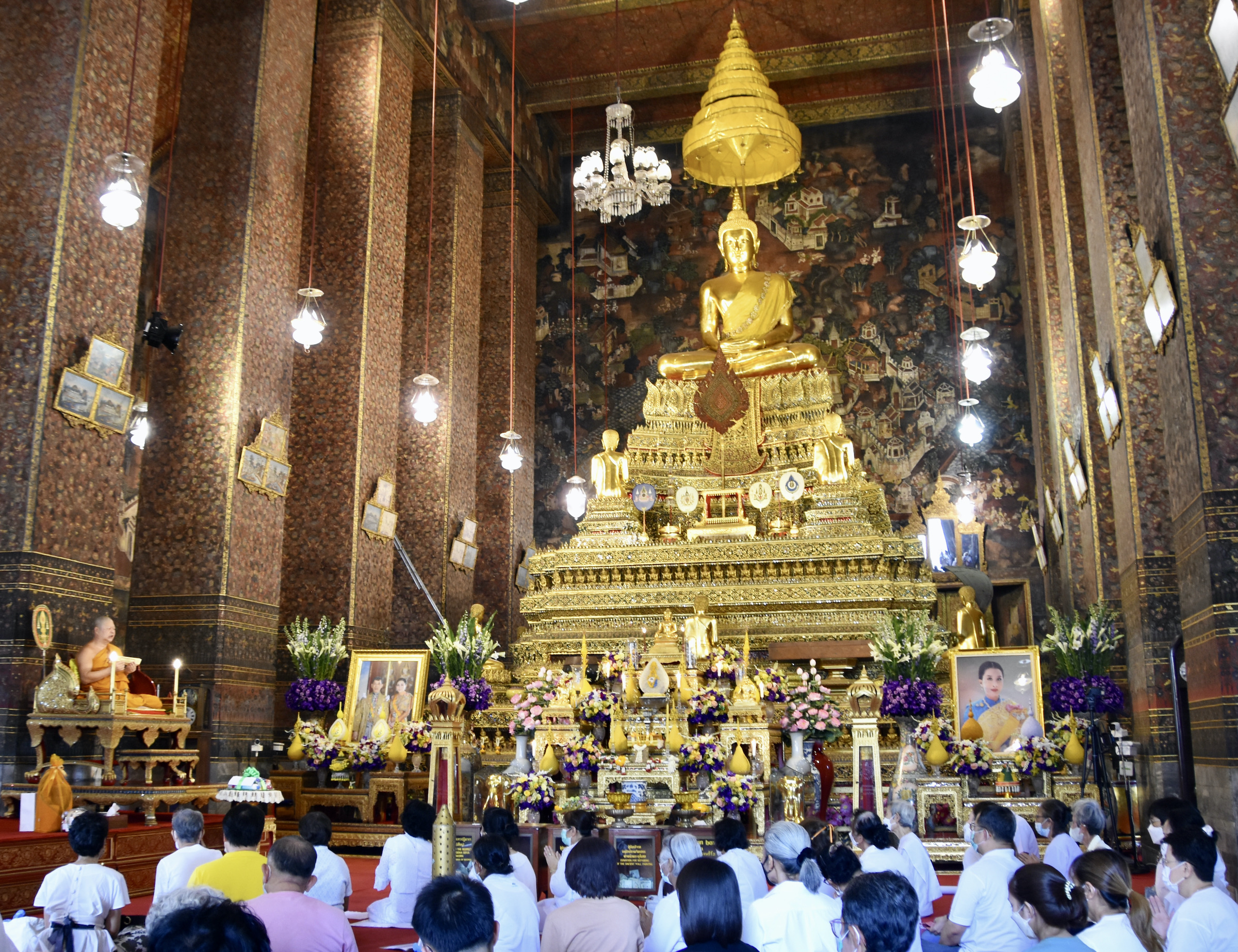
Also found within the walls of the cloister are four stupas, one at each corner representing the Four Cardinal Points, an important feature of both Buddhism and Hinduism. This is a photo one one of them. Note the bonsai trees at the base.
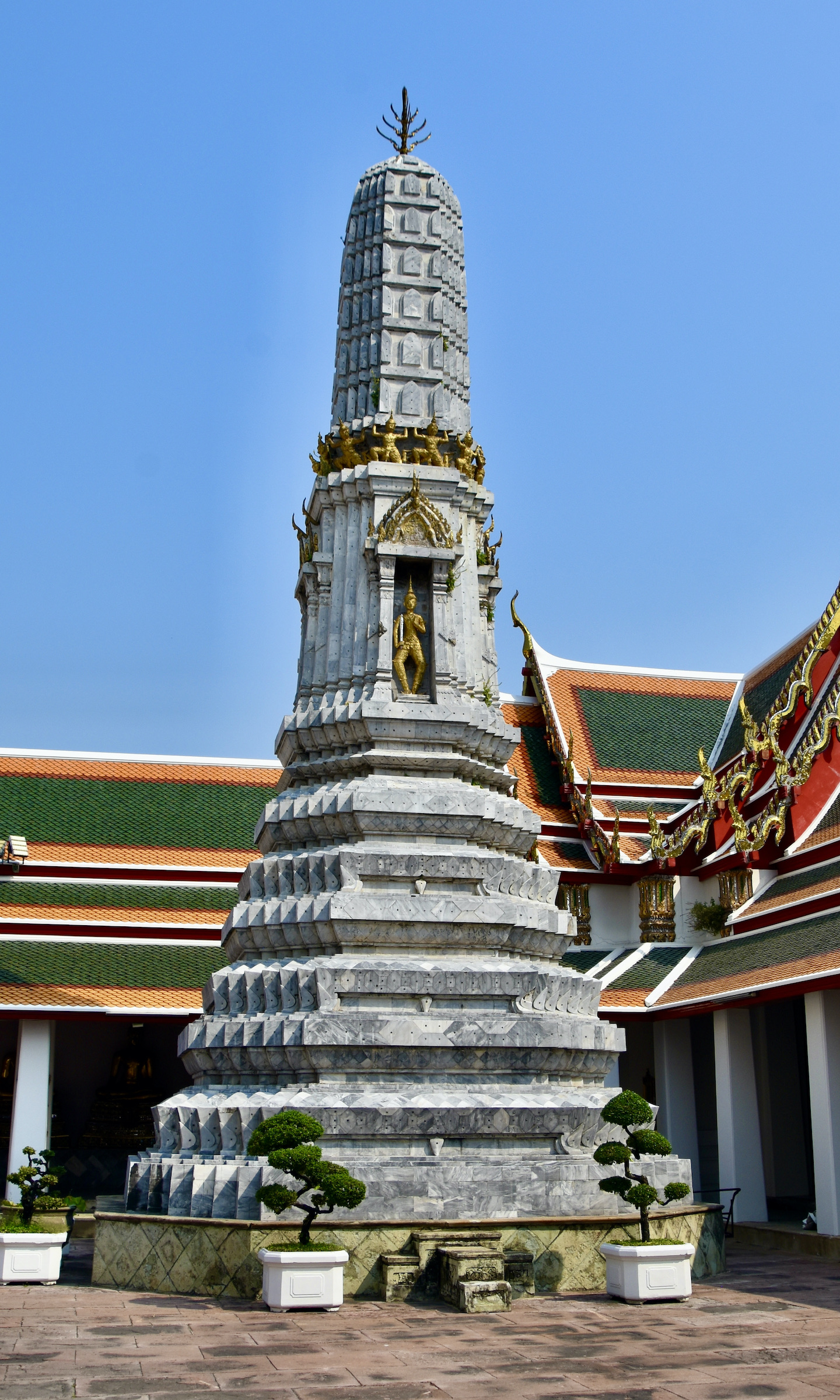
We now left the enclosed area of Wat Pho heading for the Temple of the Reclining Buddha.
Immediately to the east of the cloister there are four large chedis (aka pagodas) that collectively make up the Phra Maha Chedi Si Rajakarn complex, each one representing the rule of kings Rama I to IV. This photo from the Wat Pho website gives a much better picture than I could get of the architectural wonder of these four buildings. These are about as representative of Thai Buddhist architecture as you can get. Each is 42 metres (138 feet) high and contain at least 12 notched rings, each getting progressively smaller until ending in a spire. The one on the right was built by Rama I and contains some of his ashes as well as what the official web site calls ‘ Relics of Lord Buddha’, but what those relics are is not specified.
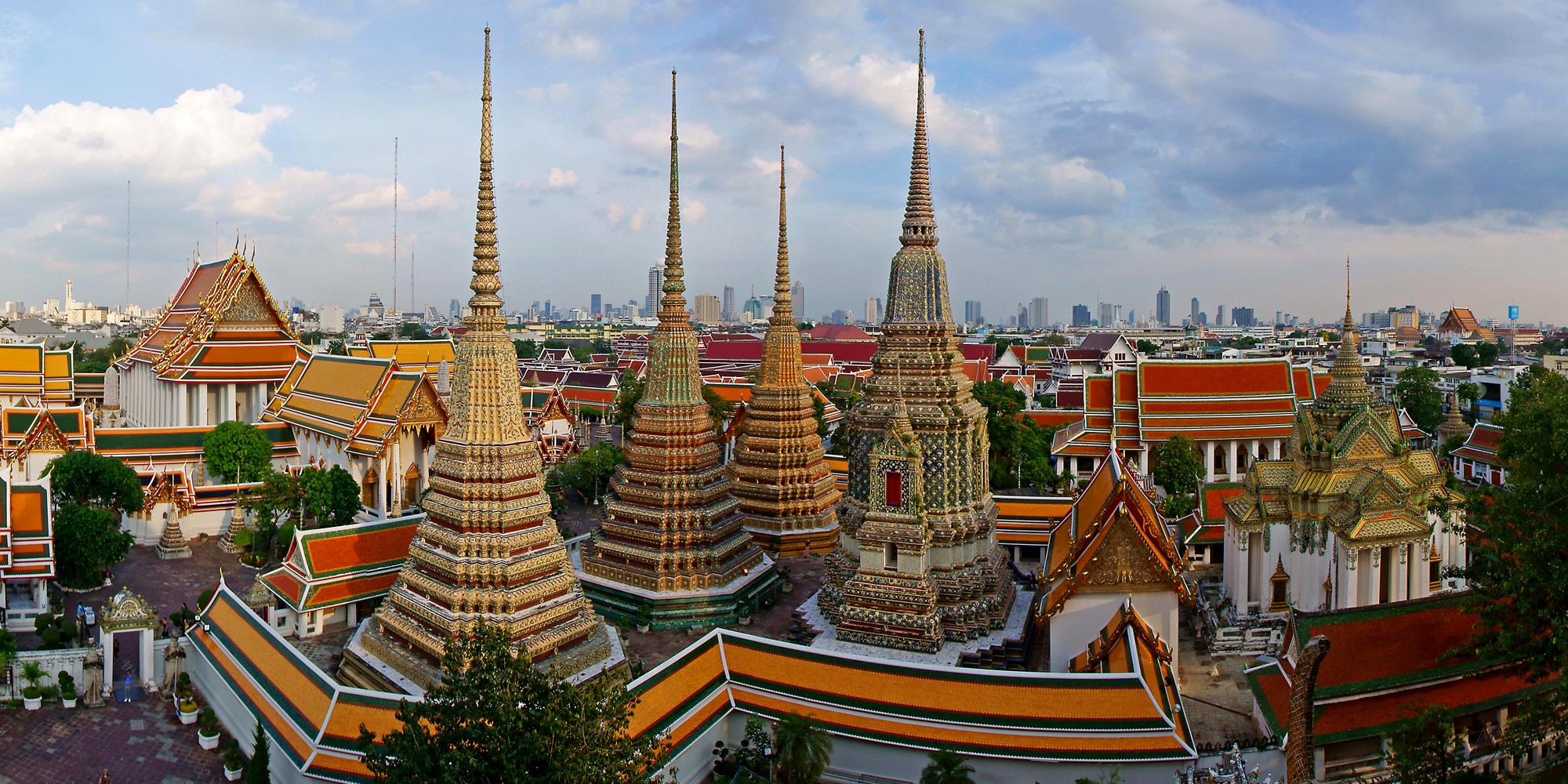
You’ll note that these four chedis are also enclosed behind a wall which is why its impossible to get a good photo at ground level. This is the best I could do, but it does show the amazingly intricate mosaics that completely cover every inch of the chedis.
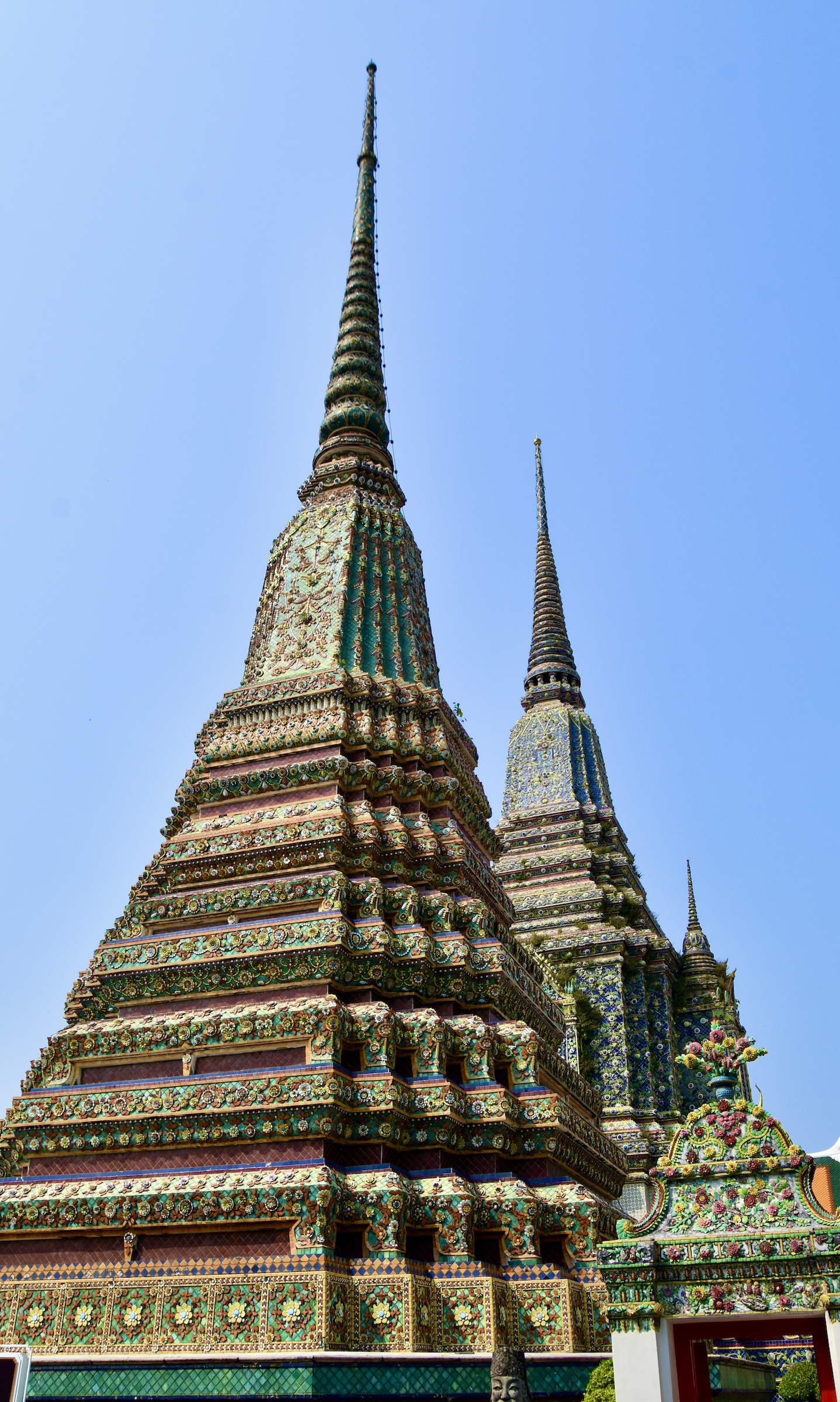
Moving on we walk through an area of gardens called the Crocodile Pond where this statue of a hermit that I call Yoga Man is found. He is one of a number in the gardens showing various yoga postures as well as Thai massage applications. I didn’t see any crocodiles.
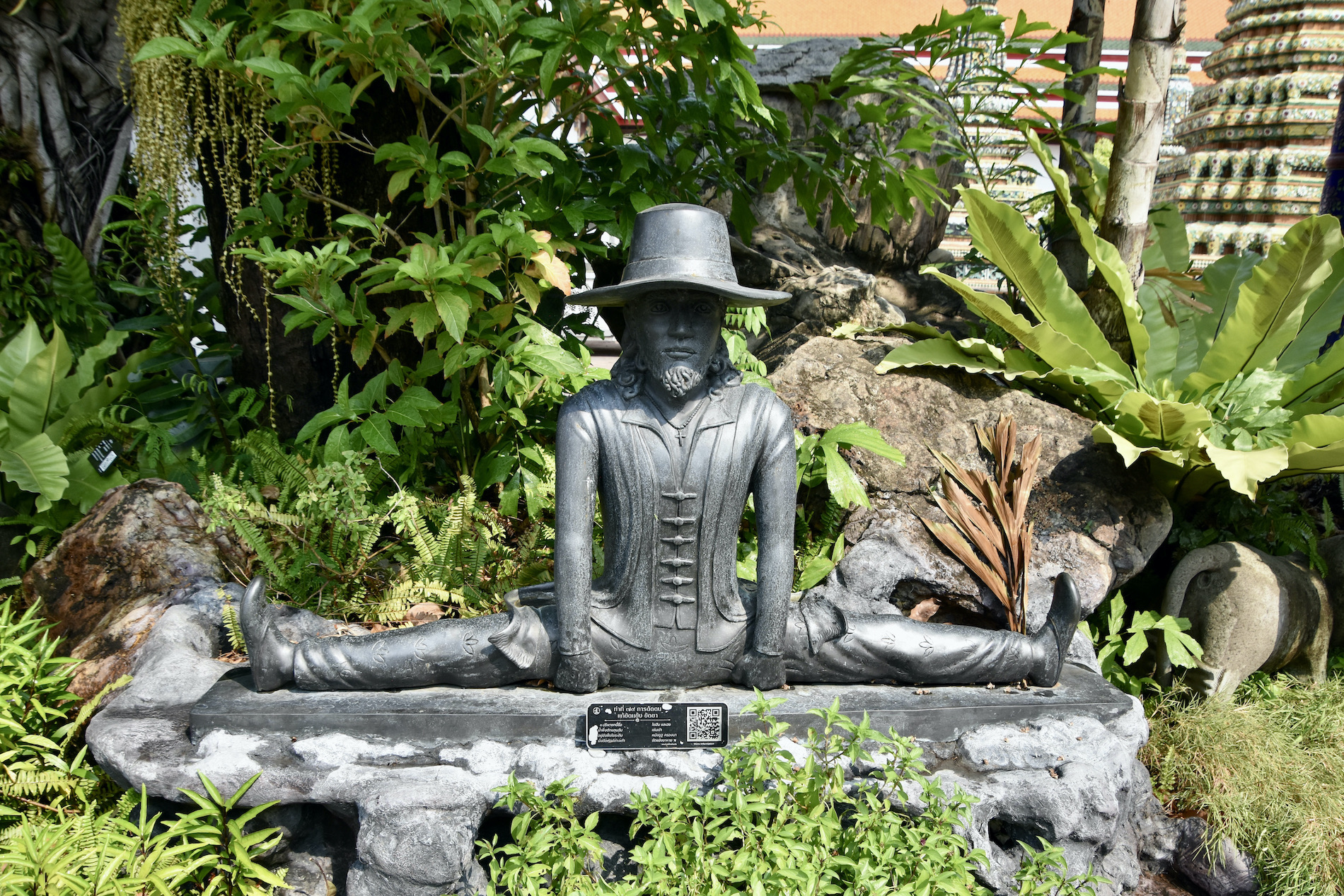
During our visit to the Grand Palace we came across a number of stone statues which we learned were carved in China and used as ballast on ships returning to Thailand from there. There are also similar statues at Wat Pho, but they are way bigger than the ones at the Grand Palace. You pass by these two on the way to the Temple of the Reclining Buddha.
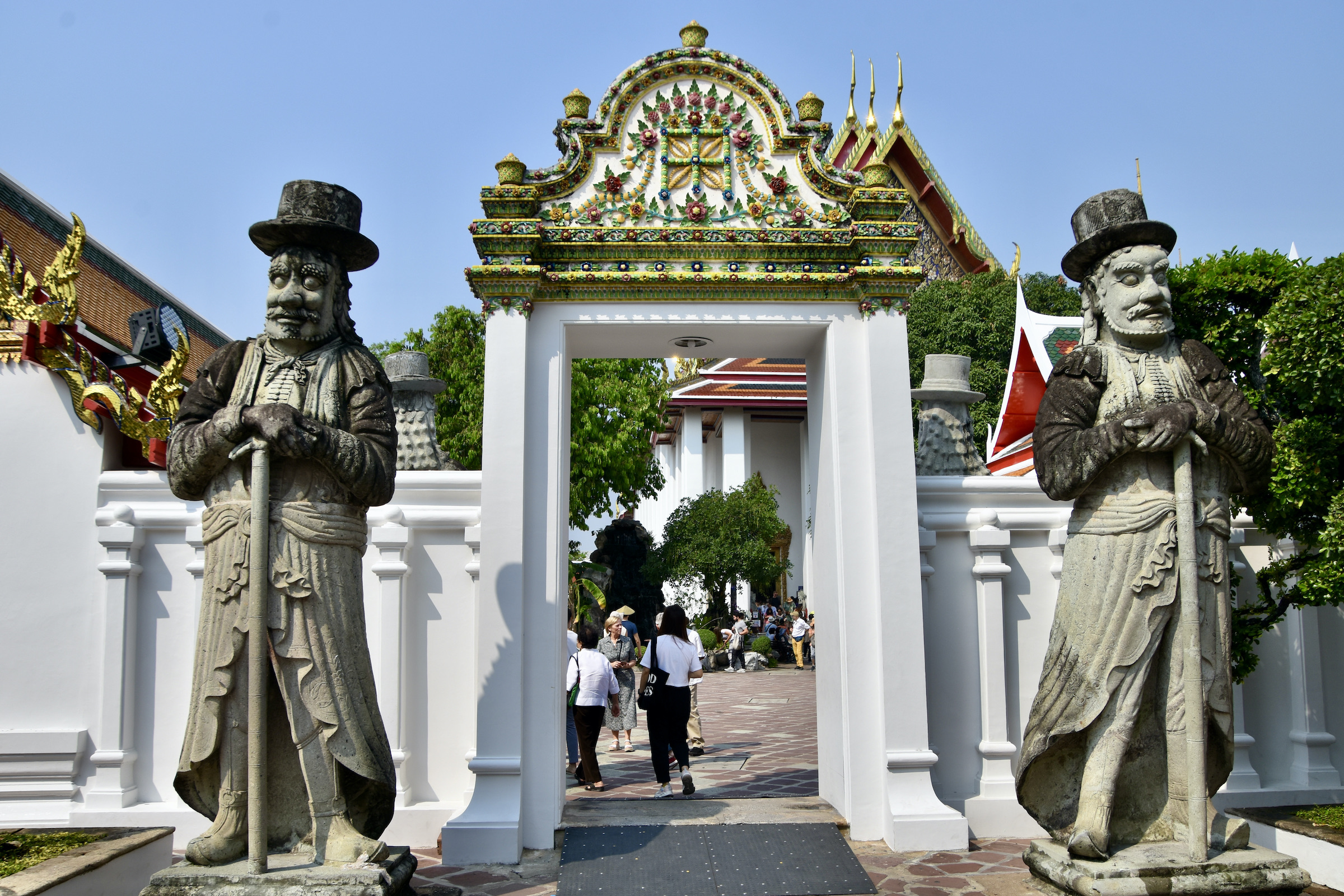
You also pass by the bell tower which is a feature of all Buddhist temples. This one is particularly elaborate and it’s not easy to see how a monk would get up there to ring it.
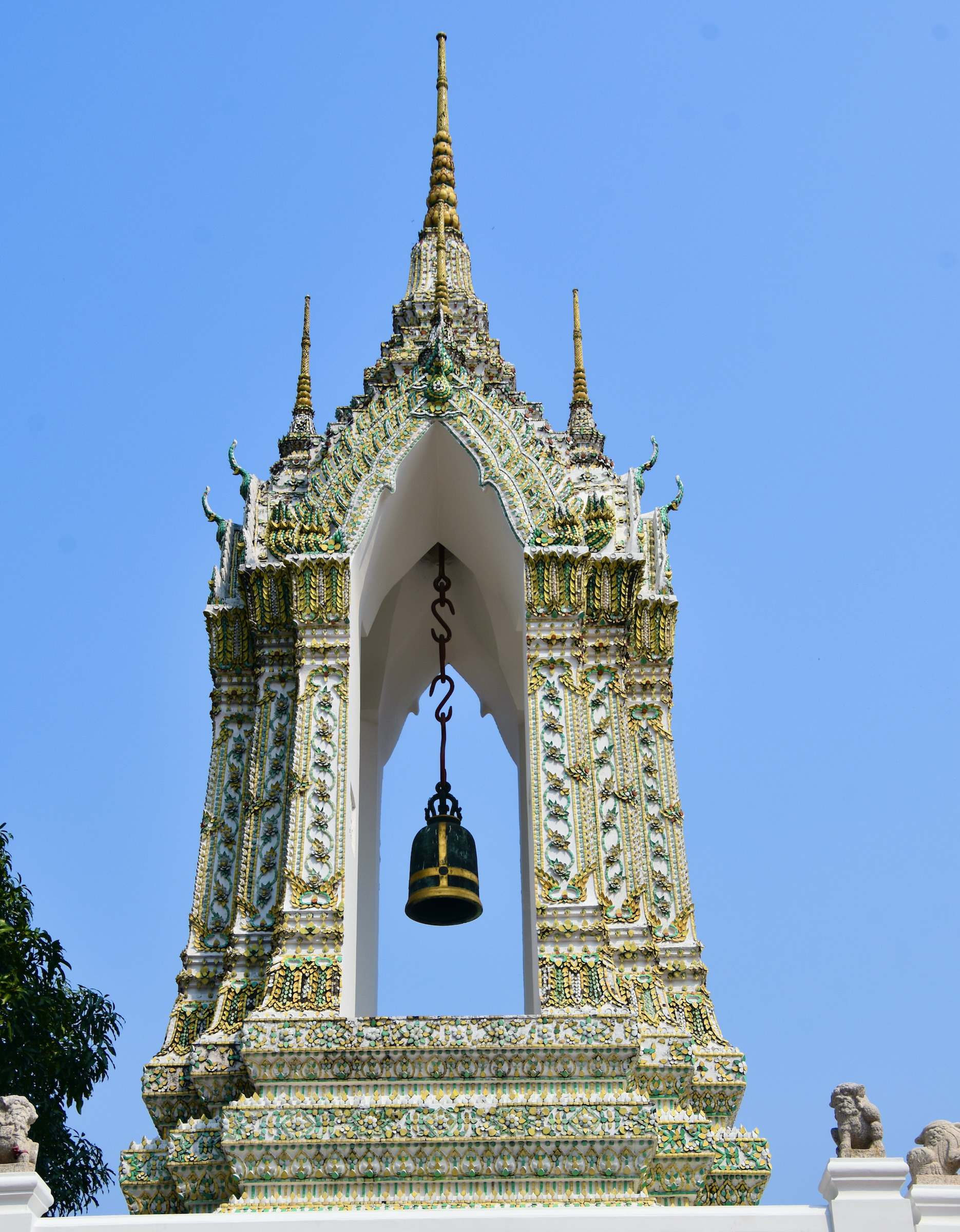
At last we arrive at the Temple of the Reclining Buddha which was built by Rama III in 1832 specifically to house the reclining Buddha. This is the exterior as shown in this photo from the official website. There were too many people around waiting to get in for me to get a good shot.
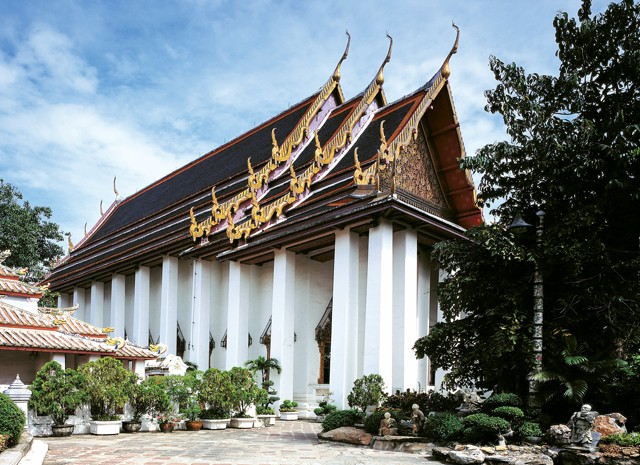
The Reclining Buddha is 46 metres (151 feet) long and 15 metres (49 feet) tall. It is in the Sihasaiyas posture which is likened to a sleeping lion and represents Buddha’s entry into Nirvana and the end of all his reincarnations. It is constructed of brick covered in plaster and then gilded with gold.
Although there is a line up to get in, it moves pretty quickly and suddenly you are you staring at this amazing head with ivory eyes and a sublime smile.
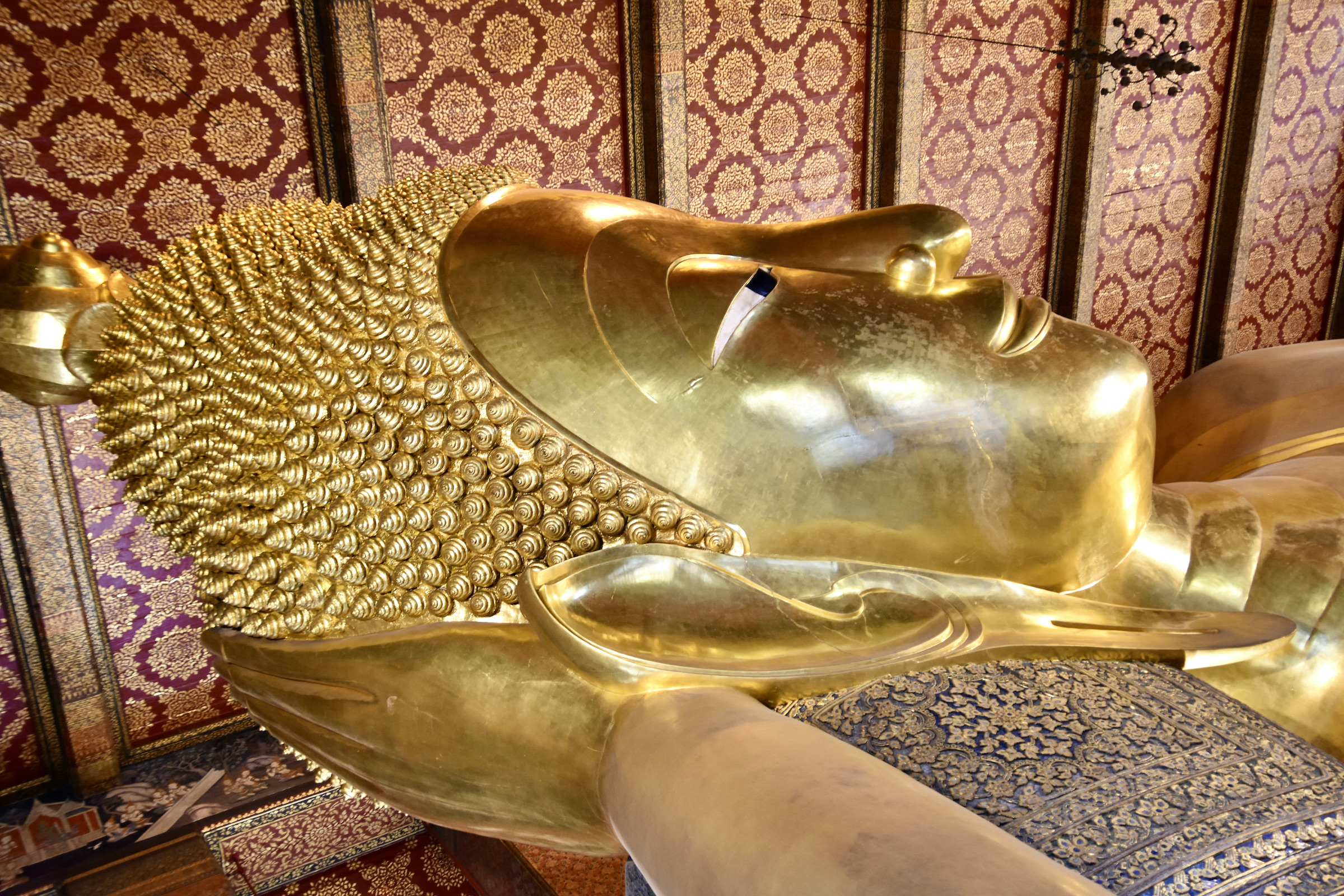
There are a number of spots where you can get a perspective on just how big this statue is. I’ve never seen anything like it.
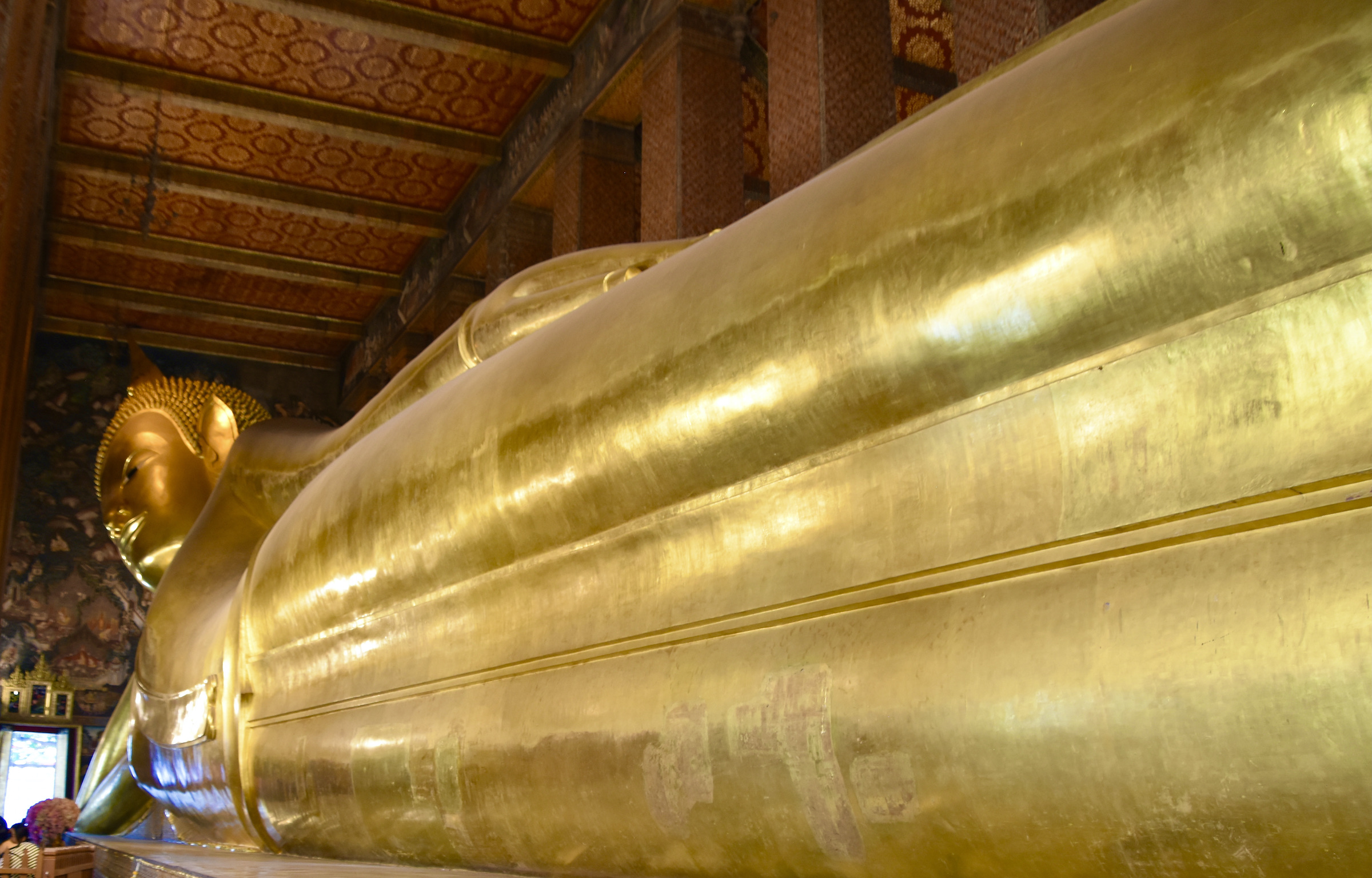
There is even a place to get a decent photo without too many other people in it. I could have edited out the photo bomber, but chose not to.
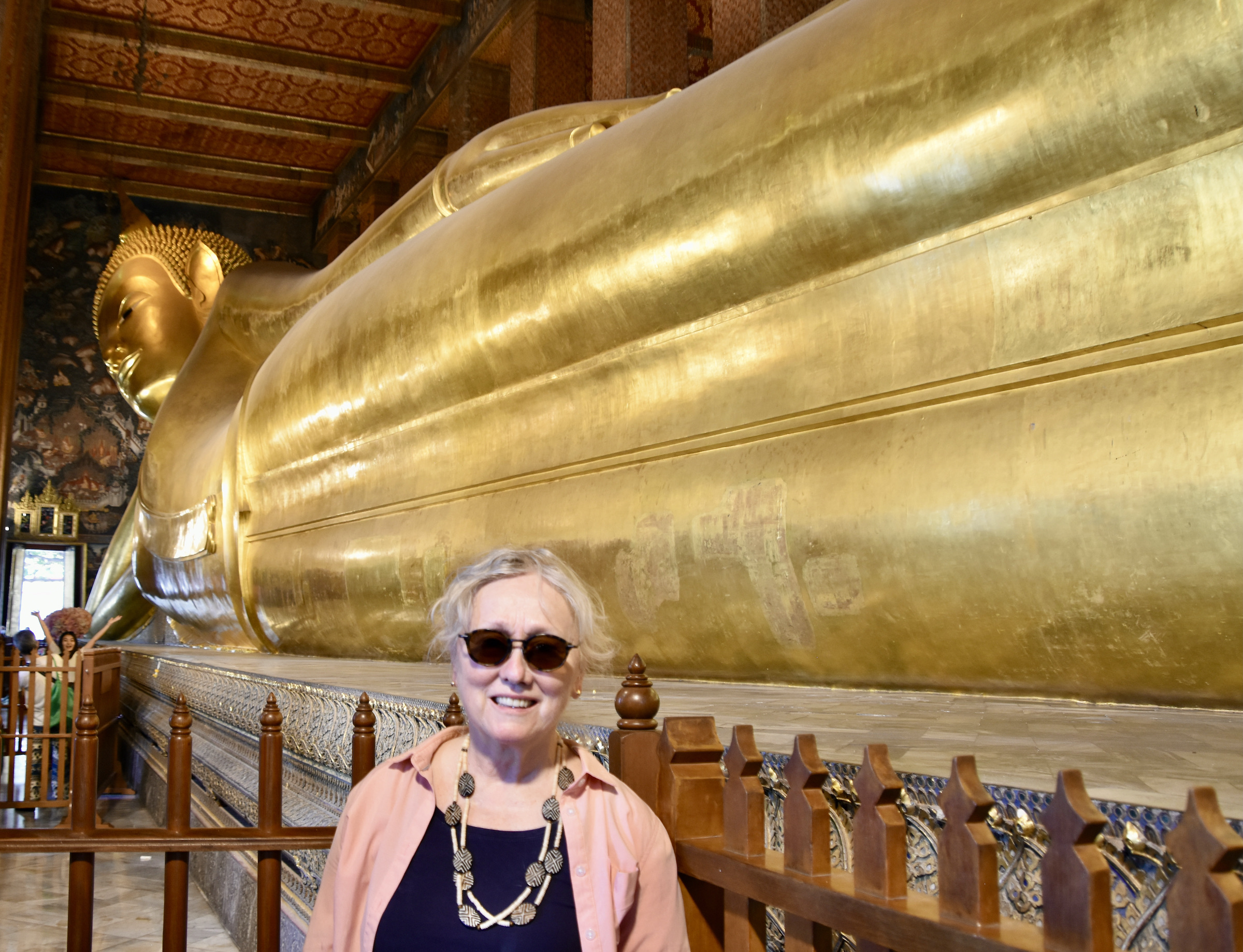
While that concludes our tour of Wat Pho we still have one more temple complex to explore in Bangkok.
The Temple of Dawn
Our final stop on this visit will be at Wat Arun, more familiarly known as the Temple of Dawn. Unlike the other places we have been visiting in Bangkok it lies on the south bank of the Chao Phraya River so to get there we need to take a ferry. The ferry dock is within easy walking distance of Wat Pho and as we approach it our guide Su points out this building which is a public washroom. Okay, what’s the big deal with that?
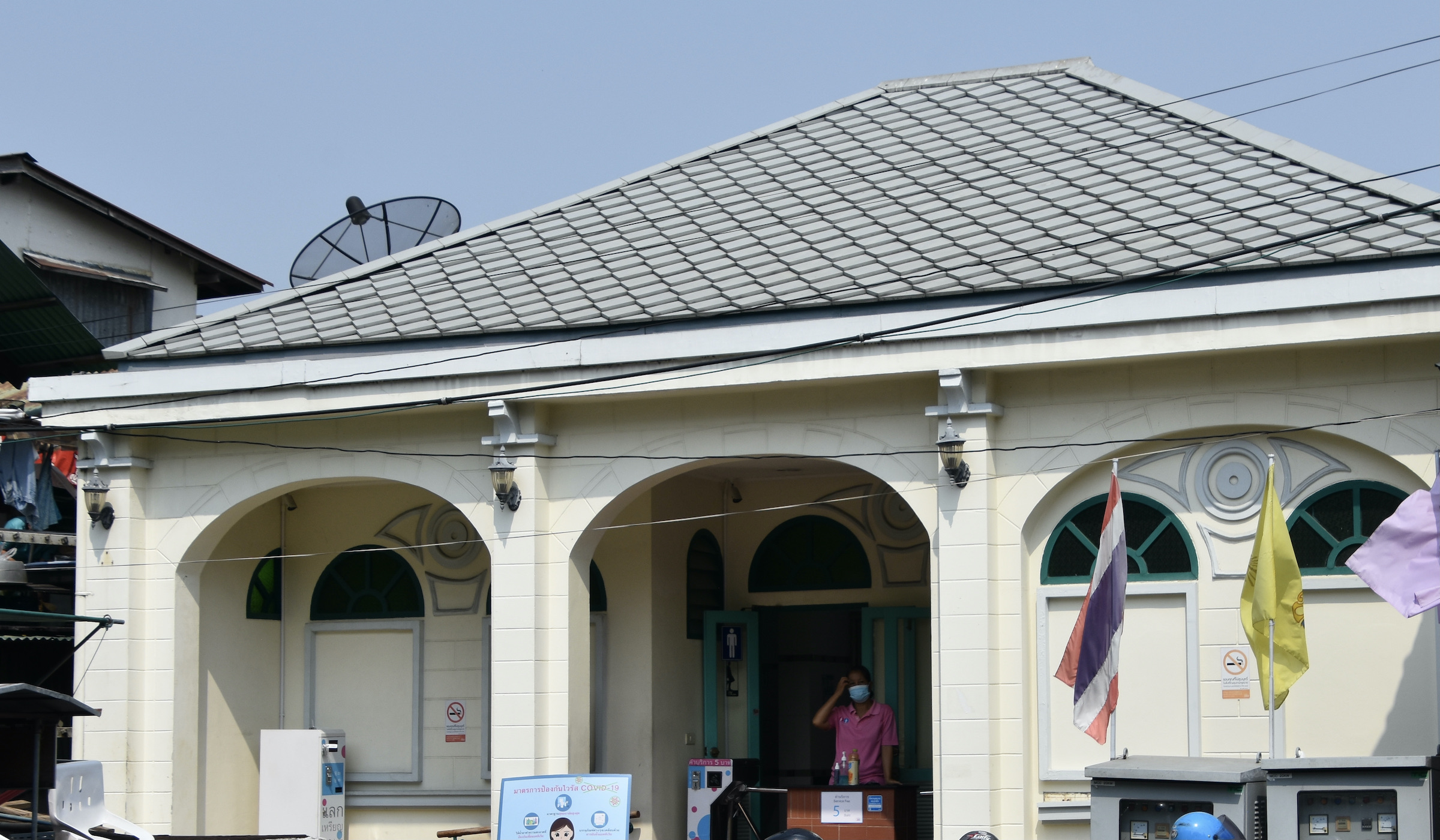
Turns out this was formerly the house where Anna Leonowens lived for six years while tutoring the 39 wives and 82 children of King Mongkut (aka Rama IV) of Siam from 1862 to 1867. You might not recognize her name, but you definitely know here as the heroine of the novel Anna and the King of Siam which was based on her diaries. The novel was made into a hit movie and then became even bigger as the basis for the smash musical The King and I which was also made into a blockbuster movie. The only problem was that the people of Thailand found the book, movies and musical offensive, portraying the king as not only a despot, but a bit of a buffoon as well. The musical is still banned in Thailand. So turning the former house into a public washroom was not such a bad idea to the Thai people.
Incidentally, after Leonowens left Siam she spent a number of years in my home city of Halifax, Nova Scotia where she was one of the founders of the Nova Scotia College of Art and Design. The art gallery there bears her name.
Getting back to our day’s exploration we boarded the ferry and approached the Temple of Dawn from the river from where you get this great view of the huge stupa/pagoda that dominates the shoreline.
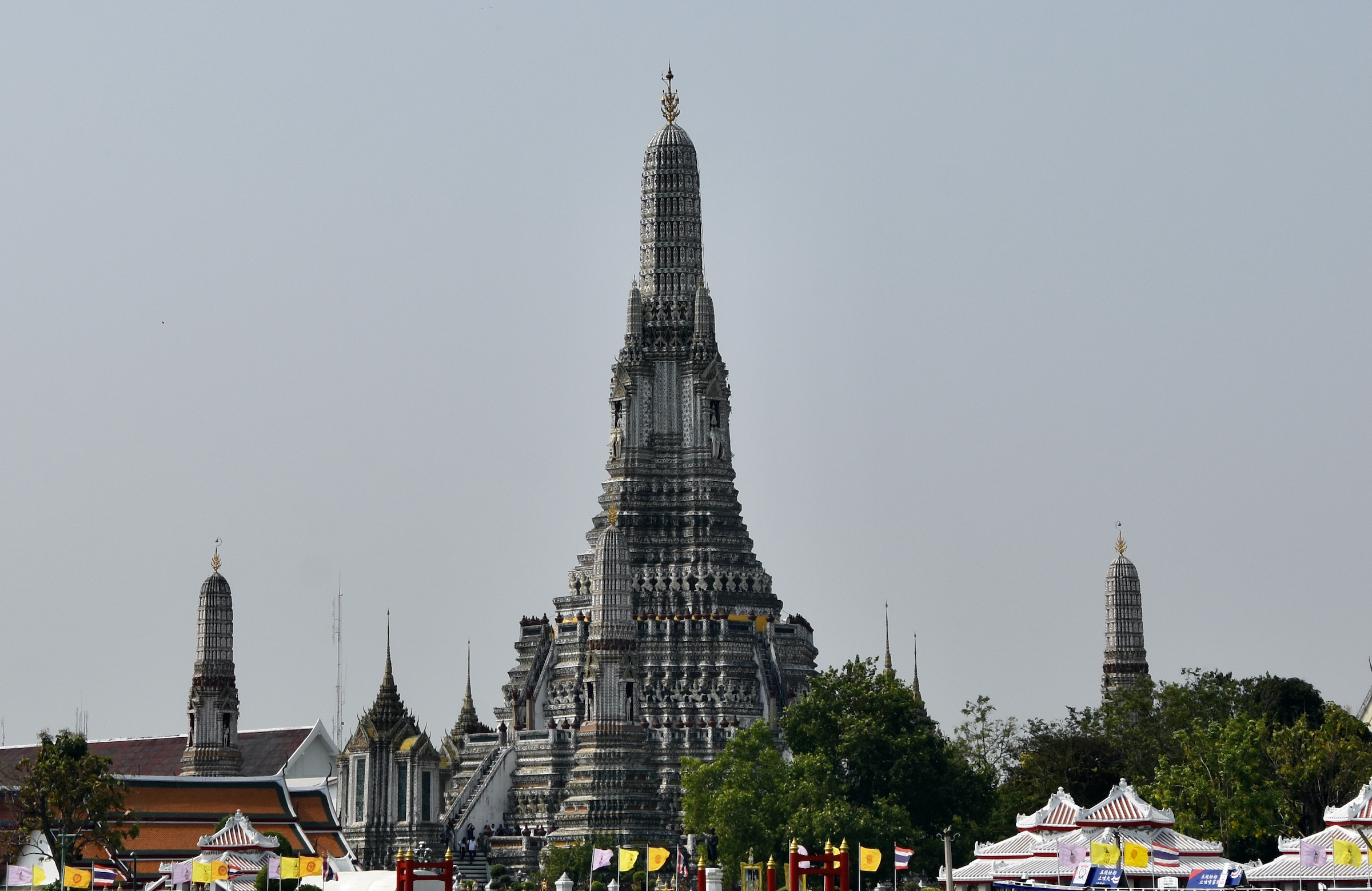
There has been a temple on this site since well before the foundation of Bangkok. After the destruction of Ayutthaya in 1767 the Siamese capital was moved to this area on the Chao Phraya River and it briefly was the home of the Emerald Buddha until it was moved to the Grand Palace grounds in 1784. After being abandoned for a number of years, King Rama II and Rama III not only restored it, but built something much grander. What you see today was completed in 1851 and has since been restored a number of times, most notably in 2017 when many broken porcelain tiles were replaced.
Unlike Wat Pho, the Temple of Dawn is essentially the one stand alone building surrounded by a number of smaller prangs. The name Wat Arun refers to the Hindu god Aruna who is often portrayed as the rays of the rising sun, thus the English name for the place. Although it is a Buddhist temple, there are many elements of Hindu mythology incorporated into it, once again reminding me of the close relationship between these two religions.
Not surprisingly given the recent restorations, the Temple of Dawn looks almost Disneyesque in appearance. It truly is a wonder to behold up close.
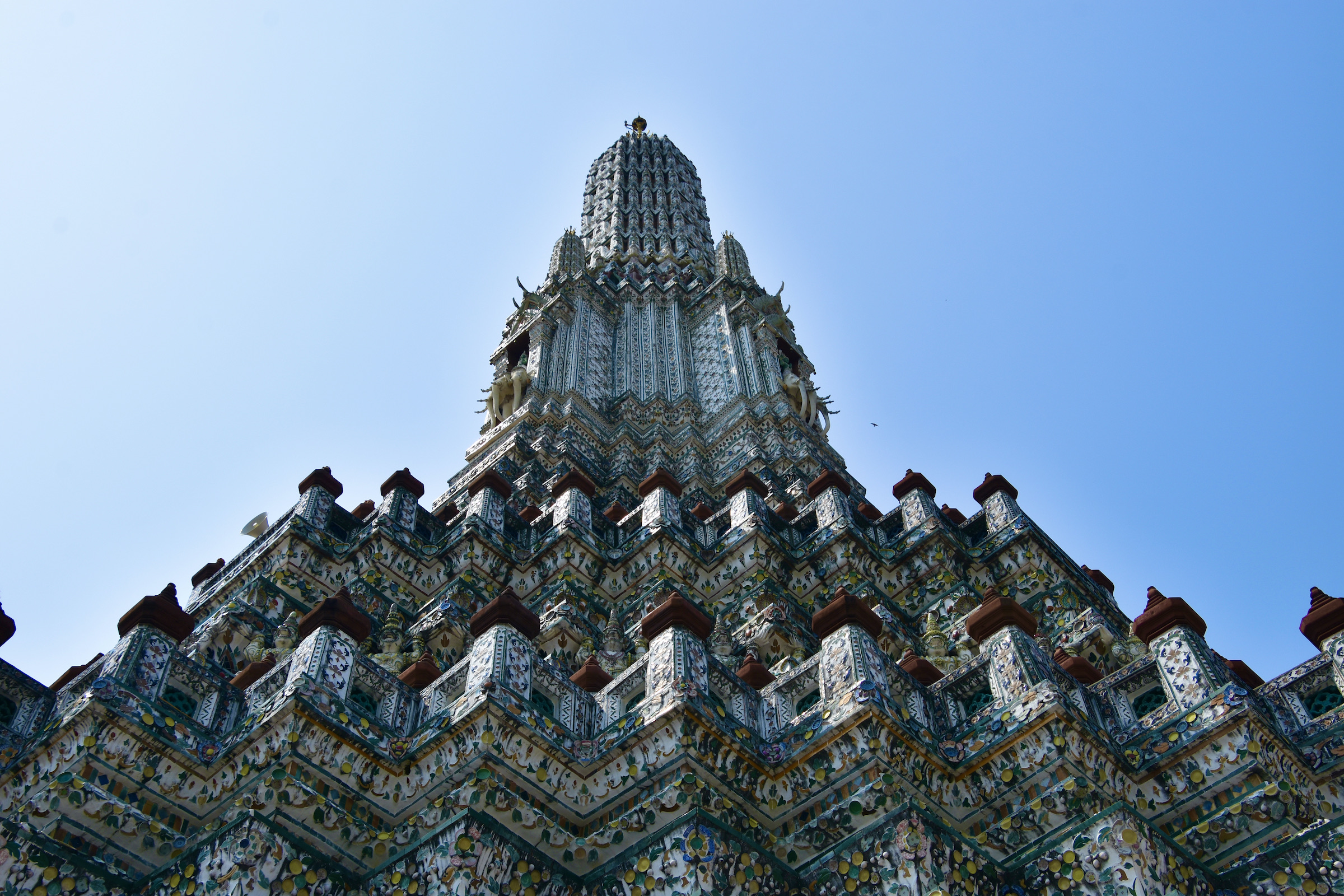
The temple is meant to be a representation of Mount Meru, the cosmological centre of the universe in Buddhist theology and at 82 metres (270 feet) it is the highest religious structure in Bangkok. It is divided into three distinct sections. The base represents all levels of existence, the middle represents the Bhuddist heaven inhabited by 32 gods and the top six more heavens within the seven realms of happiness. I’m only quoting this from the Wikipedia entry and other sources and have no clue what this actually means.
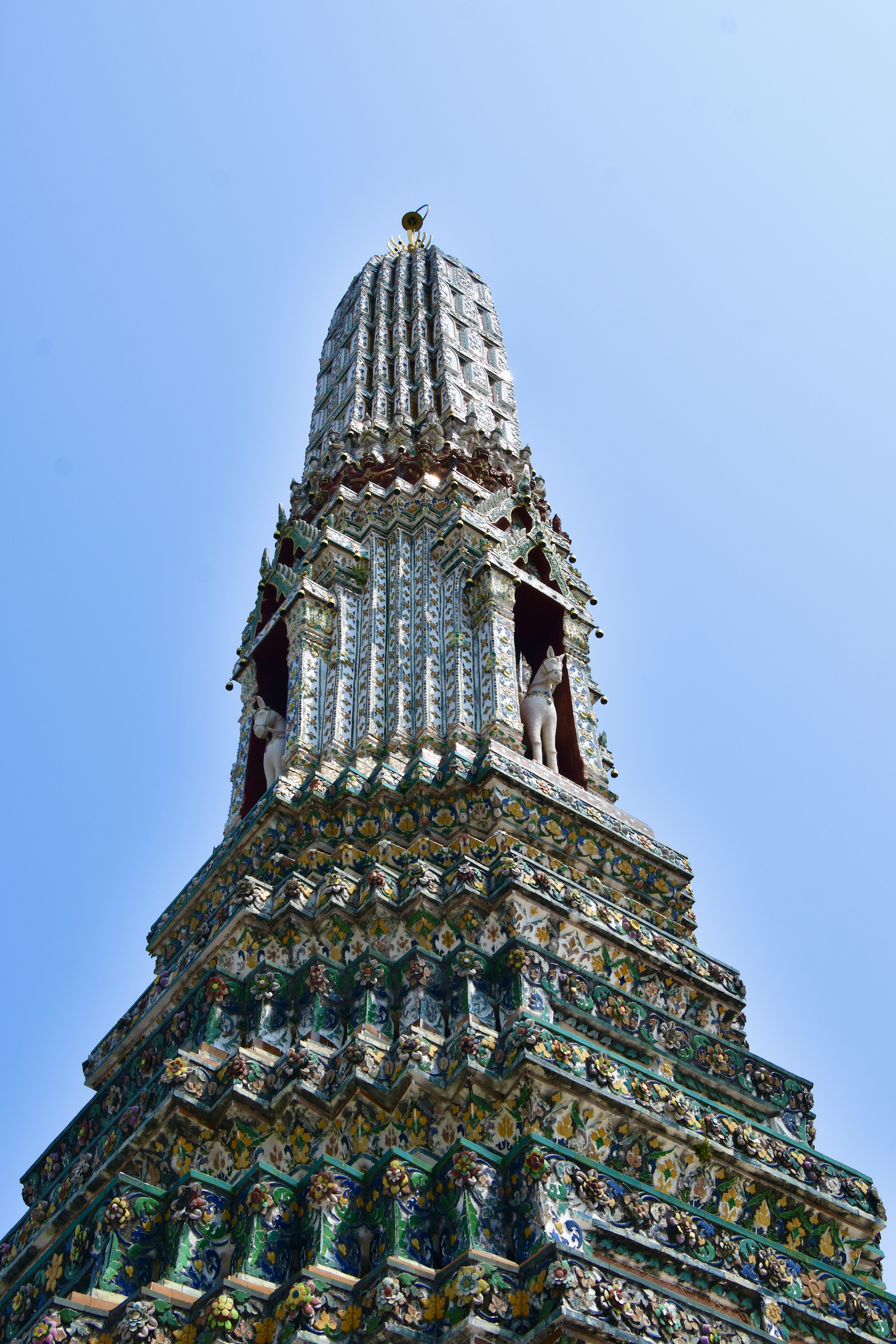 Top of the Temple of Dawn
Top of the Temple of Dawn
What is I can get my head around is the stunning details to be found everywhere you look, such as these masked demons.
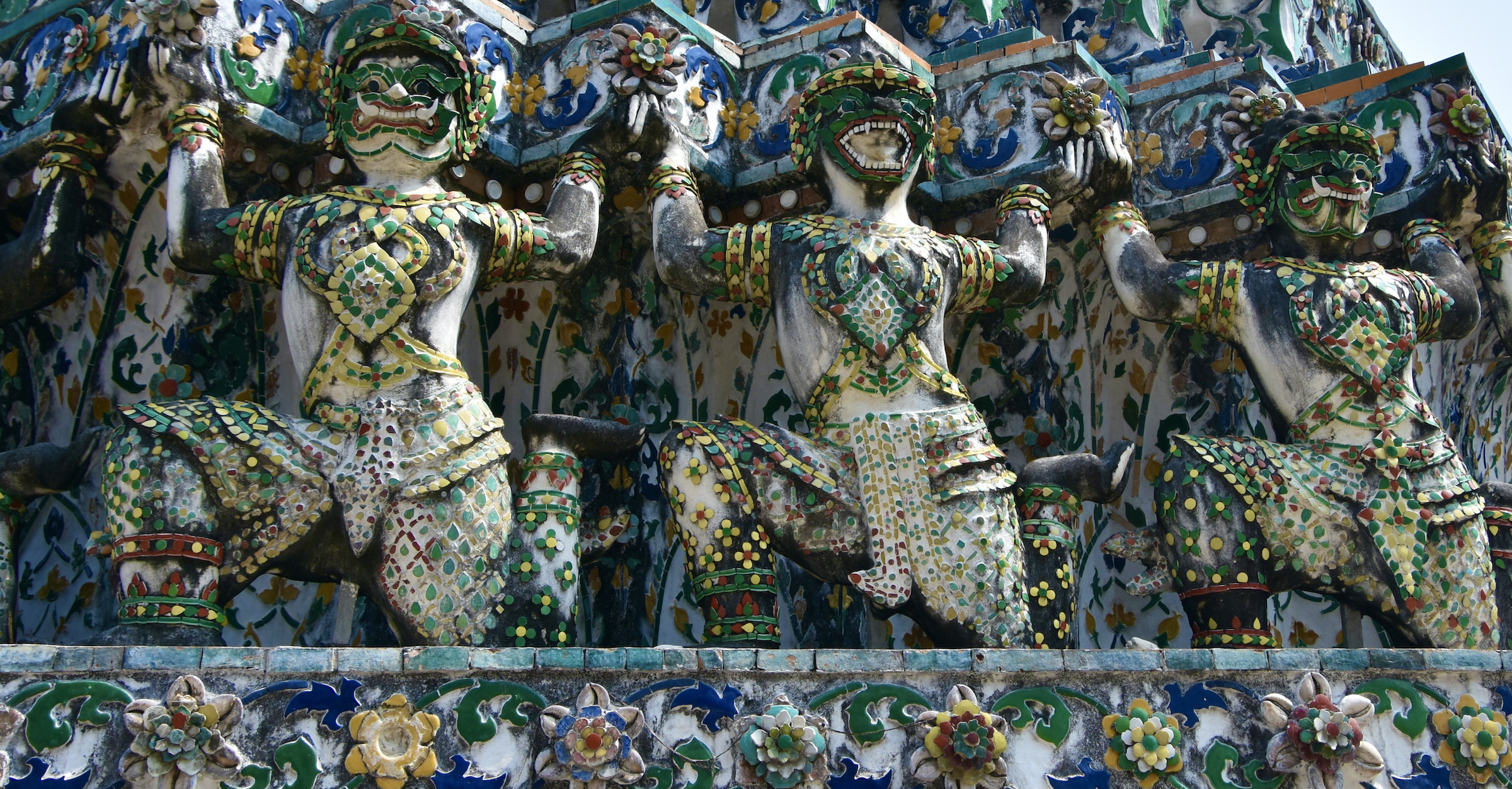
And these bare faced white figures.
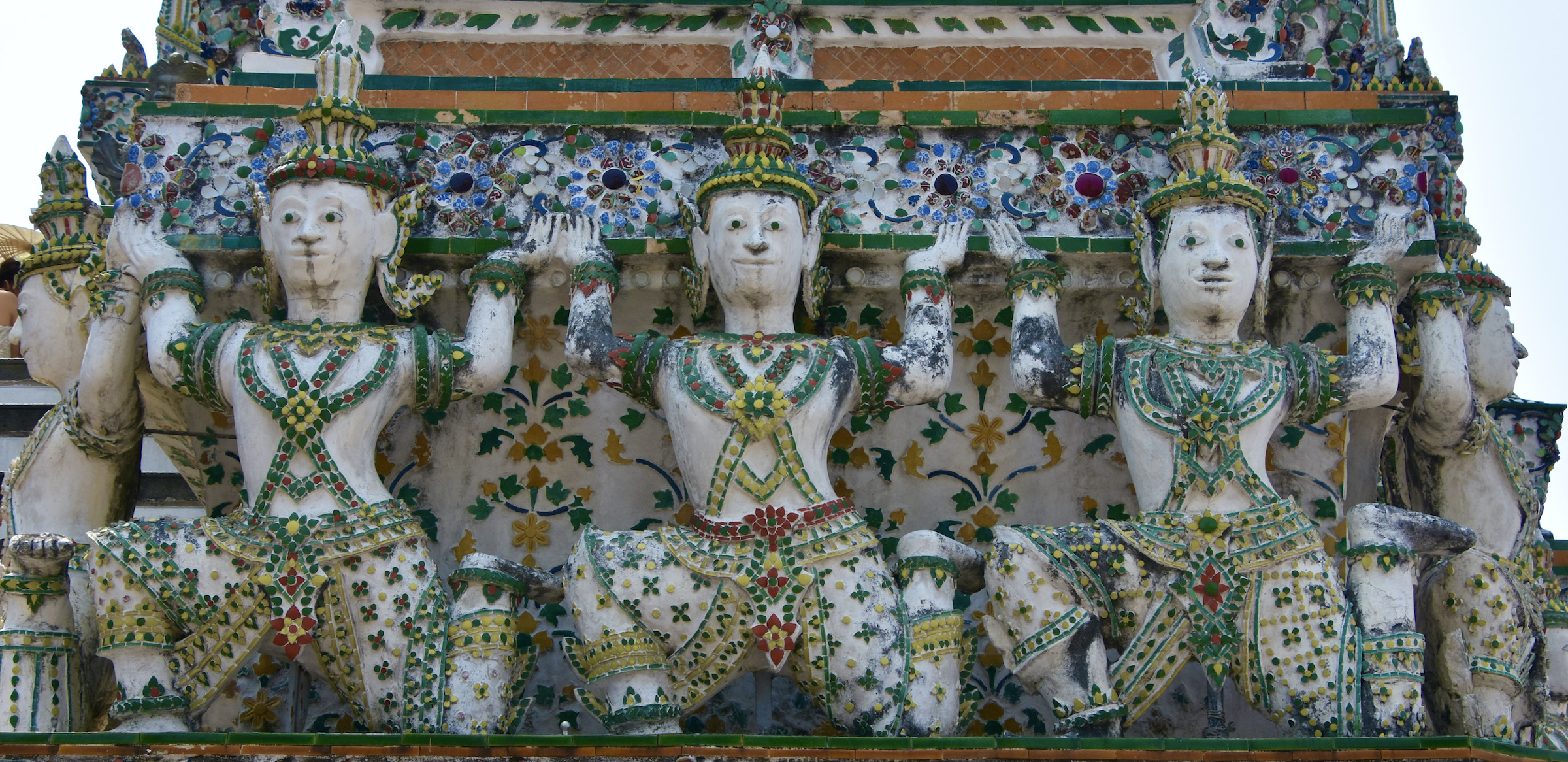
There is so much to take in both here and at Wat Pho that it would take at least two visits to really get a better understanding of what these fabulous monuments are meant to portray to the average person; even more so for a person grown up with the Judeo-Christian western canon and the Greek myths as the basis of our world view. All I can say is that you don’t have to understand it to appreciate its beauty and sensory impact.
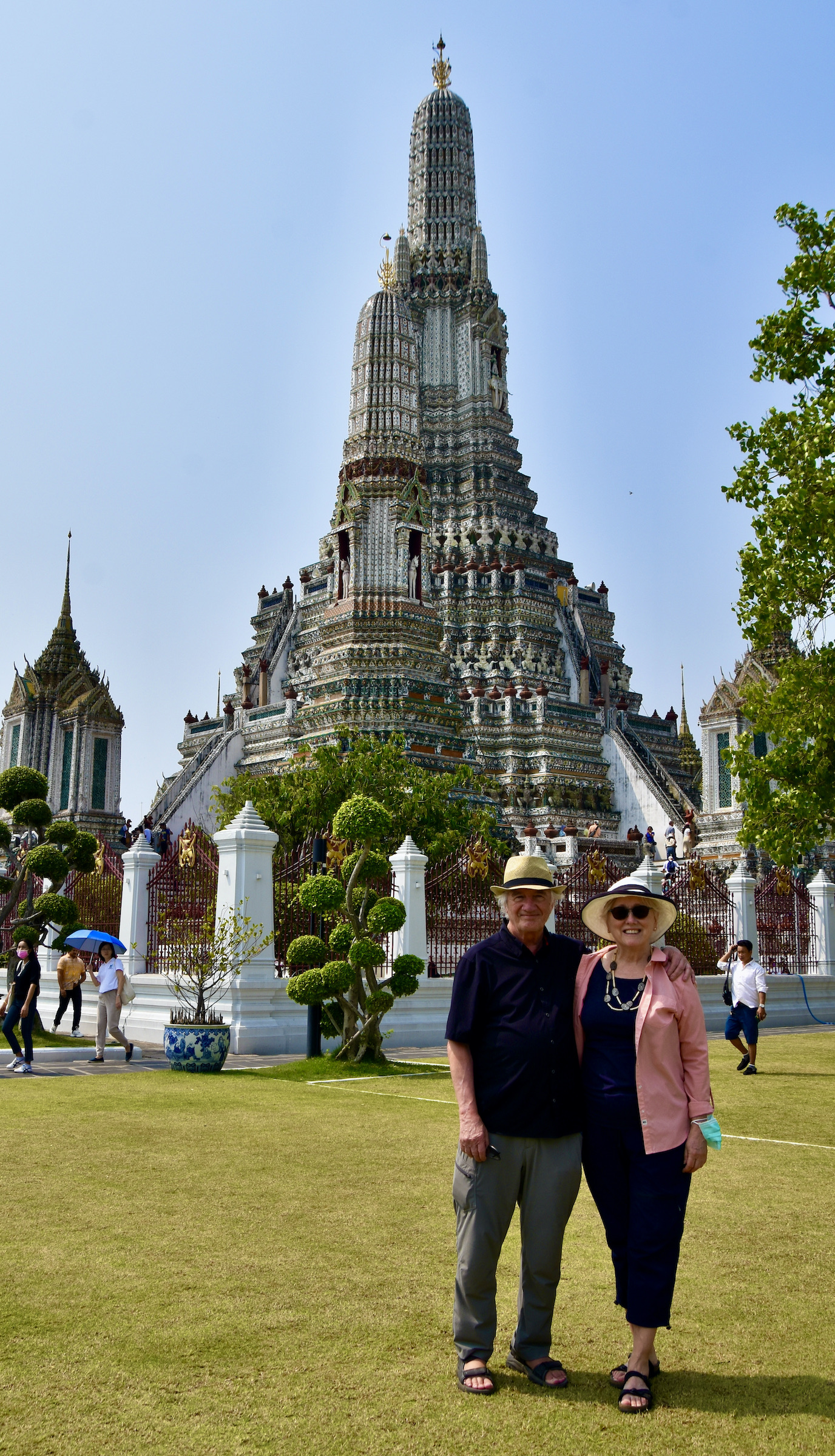
We end our visit with Su taking this photo to remind us of this great day in Bangkok.
In the next post we will fly to Luang Prabang and begin our Adventures Abroad tour of southeast Asia. Please join us.

